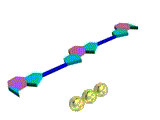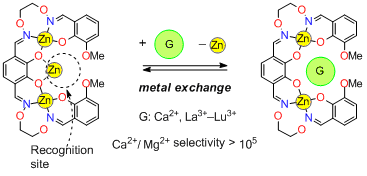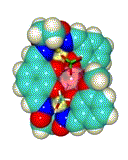RESEARCH TOPICS
Shaping molecules to capture metal ions
Ion recognition phenomenon, i.e., binding of a host molecule to a guest species such as a metal or organic ion, is recognized as the first step of responsive molecular functions like an enzyme-substrate binding. If the first molecular recognition of a system enhances the subsequent binding with the second or third species, the system will be useful for signal transduction and transformation.
We designed an ion recognition system in which complexation with d-block transition metal ions causes a structural change to promote the guest ion binding.

Upon the complexation with zinc(II) ion, a linear bis(salen)-type ligand underwent structural change to be C-shaped, as we expected. However, zinc(II) ion was introduced also in the central recognition site in addition to the two salen-type coordination sites. Although the recognition site was occupied, the trinuclear complex recognized a guest metal ion such as Ca2+ and lanthanide(III) with concomitant release of the central zinc(II). The trinuclear complexes showed a high Ca2+/Mg2+selectivity (~105), which is comparable to that of BAPTA, known as useful intracellular Ca2+ receptor. This is the first example of ion recognition using a metal exchange protocol.

[Hover to animate]


[Hover to animate]

[Hover to animate]
[References]
“Novel Synthetic Approach to Trinuclear 3d-4f Complexes: Specific Exchange of the
Central Metal of a Trinuclear Zinc(II) Complex of a Tetraoxime Ligand with a Lanthanide(III) Ion”
Akine, S.; Taniguchi, T.; Nabeshima, T.
Angew. Chem. Int. Ed. 2002, 41, 4670-4673.
doi:10.1002/anie.200290011
“Ca2+- and Ba2+-Selective Receptors Based on Site-Selective
Transmetalation of Multinuclear Polyoxime-Zinc(II) Complexes”
Akine, S.; Taniguchi, T.; Saiki, T.; Nabeshima, T.
J. Am. Chem. Soc. 2005, 127, 540-541.
doi:10.1021/ja046790k
“Helical Metallohost-Guest Complexes via Site-Selective Transmetalation of Homotrinuclear Complexes”
Akine, S.; Taniguchi, T.; Nabeshima, T.
J. Am. Chem. Soc. 2006, 128, 15765-15774.
doi:10.1021/ja0646702

